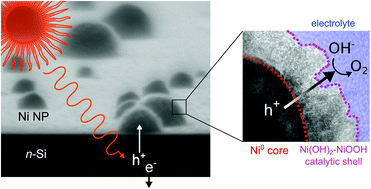当前位置:
X-MOL 学术
›
Energy Environ. Sci.
›
论文详情
Our official English website, www.x-mol.net, welcomes your
feedback! (Note: you will need to create a separate account there.)
Elucidating the performance and unexpected stability of partially coated water-splitting silicon photoanodes†
Energy & Environmental Science ( IF 32.4 ) Pub Date : 2018-06-26 00:00:00 , DOI: 10.1039/c8ee00980e Kiseok Oh 1, 2, 3, 4, 5 , Cristelle Mériadec 1, 2, 4, 5, 6 , Benedikt Lassalle-Kaiser 5, 7, 8, 9, 10 , Vincent Dorcet 1, 2, 3, 4, 5 , Bruno Fabre 1, 2, 3, 4, 5 , Soraya Ababou-Girard 1, 2, 4, 5, 6 , Loïc Joanny 1, 2, 4, 5, 11 , Francis Gouttefangeas 1, 2, 4, 5, 11 , Gabriel Loget 1, 2, 3, 4, 5
Energy & Environmental Science ( IF 32.4 ) Pub Date : 2018-06-26 00:00:00 , DOI: 10.1039/c8ee00980e Kiseok Oh 1, 2, 3, 4, 5 , Cristelle Mériadec 1, 2, 4, 5, 6 , Benedikt Lassalle-Kaiser 5, 7, 8, 9, 10 , Vincent Dorcet 1, 2, 3, 4, 5 , Bruno Fabre 1, 2, 3, 4, 5 , Soraya Ababou-Girard 1, 2, 4, 5, 6 , Loïc Joanny 1, 2, 4, 5, 11 , Francis Gouttefangeas 1, 2, 4, 5, 11 , Gabriel Loget 1, 2, 3, 4, 5
Affiliation

|
H2 is an ideal energy carrier because it has a high energy density, and it can be easily stored, transported, and readily used to power electrical devices. Like photosynthesis, where photons are converted into energy-rich molecules, sunlight energy can be converted into H2 and O2 using photoelectrochemical water splitting cells (PECs). Despite the fact that silicon is considered one of the most attractive semiconductors for manufacturing photoelectrodes, its use is currently limited by its low activity and its instability in aqueous solutions. Herein, we report on surprisingly stable Si-based photoanodes, fabricated by simple aqueous electrodeposition, which results in the partial (<20%) coating of the Si surface with dispersed Ni nanoparticles (NPs). We show that photoelectrochemical activation considerably improves their performance by generating a high-activity catalytic shell around the Ni NPs. In addition, we demonstrate the stability of the photoanodes under various conditions in highly corrosive alkaline solutions in operation and in inactivity. The protection in operation is explained by anodic passivation, which generates a stabilizing SiOx layer. In contrast, the stability when no polarization is applied is unexpected because most of the Si, highly prone to etching, is in contact with the very corrosive aqueous phase. The experimental data allow us to propose a mechanism explaining this effect.
中文翻译:

阐明部分涂覆的水分解硅光阳极的性能和出乎意料的稳定性†
H 2是理想的能量载体,因为它具有很高的能量密度,并且可以轻松存储,运输并易于为电子设备供电。类似于光合作用,其中光子被转换为能量丰富的分子,阳光能量可以被转换为H 2和O 2使用光电化学水分解池(PEC)。尽管事实上硅被认为是制造光电极的最有吸引力的半导体之一,但是其使用目前受到其低活性和在水溶液中的不稳定性的限制。本文中,我们报道了通过简单的水性电沉积制备的出乎意料的稳定的基于Si的光阳极,其导致分散有Ni纳米颗粒(NPs)的Si表面被部分(<20%)覆盖。我们表明,通过在Ni NPs周围产生高活性的催化壳层,光电化学活化大大提高了它们的性能。此外,我们证明了在高腐蚀性碱性溶液中,在操作和非活性条件下,光阳极在各种条件下的稳定性。阳极钝化解释了运行中的保护,x层。相反,没有极化时的稳定性是出乎意料的,因为高度易蚀刻的大多数Si与腐蚀性很强的水相接触。实验数据使我们能够提出一种解释这种作用的机制。
更新日期:2018-06-26
中文翻译:

阐明部分涂覆的水分解硅光阳极的性能和出乎意料的稳定性†
H 2是理想的能量载体,因为它具有很高的能量密度,并且可以轻松存储,运输并易于为电子设备供电。类似于光合作用,其中光子被转换为能量丰富的分子,阳光能量可以被转换为H 2和O 2使用光电化学水分解池(PEC)。尽管事实上硅被认为是制造光电极的最有吸引力的半导体之一,但是其使用目前受到其低活性和在水溶液中的不稳定性的限制。本文中,我们报道了通过简单的水性电沉积制备的出乎意料的稳定的基于Si的光阳极,其导致分散有Ni纳米颗粒(NPs)的Si表面被部分(<20%)覆盖。我们表明,通过在Ni NPs周围产生高活性的催化壳层,光电化学活化大大提高了它们的性能。此外,我们证明了在高腐蚀性碱性溶液中,在操作和非活性条件下,光阳极在各种条件下的稳定性。阳极钝化解释了运行中的保护,x层。相反,没有极化时的稳定性是出乎意料的,因为高度易蚀刻的大多数Si与腐蚀性很强的水相接触。实验数据使我们能够提出一种解释这种作用的机制。











































 京公网安备 11010802027423号
京公网安备 11010802027423号